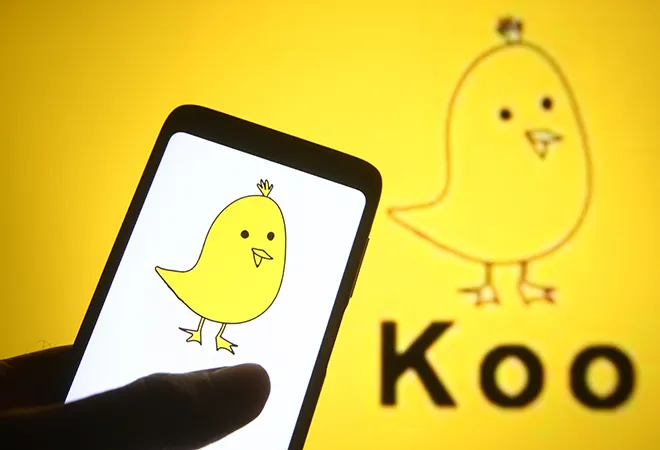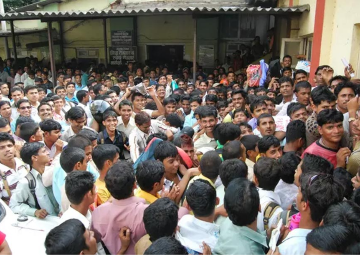Social media has greatly reconfigured the relationship between the state and its people, especially by becoming the primary avenue through which dispensations engage in narrative control, manage public opinion about policy and monitor dissenting views. To forge an alignment between the interests of the state and the discourse taking place on social media platforms has become an important policy imperative in recent years. Thus, when big technology companies such as Twitter are perceived to be going against the interests of a state, the social media marketplace that has come to resemble a ‘splinternet’, props up alternatives seemingly more sympathetic to the government’s interests.
In India, this was evident with the rise of Koo, a microblogging site emulating Twitter but promising an India centric social media experience. Barely a year old, the app was founded through the AtmaNirbhar app challenge, a government initiative encouraging self-reliance in the field of science and technology, interestingly placing social media parallel to issues such as defense technology, energy and so on. Koo’s popularity first surged in response to the clashes between India and China at Galwan Valley in summer 2020. This was the first time that a technology platform in India seemed to be responding and extracting value through geopolitical tensions with an adversary. Before this, technology platforms operated on this ambition of an interconnected world without borders, unified by technology. However, the emergence of a splinternet and governments seeking a monopoly on online discourse to fulfill strategic aims has meant that ambivalence of technology companies towards geopolitical tensions may no longer be feasible. Koo greatly benefitted from the Indian government’s decision to ban Chinese applications, a direct reaction to the Galwan crisis, as Indian users were pushed to seek homegrown products to cater to their needs and in the social media space, Koo was there to fulfill that need.
Interestingly, Koo’s parent company Vokal had raised $5 million as part of its Series A round in 2018 with China-based Shunwei Capital. The recent tensions between India and China meant that this news would be problematic for Koo’s image as a homegrown technology platform, built by the Indian people and for the Indian people. Thus, it was no surprise that in February 2021, Koo CEO tweeted the news that Koo is an “Indian registered company with Indian founders” and that Shunwei capital would be exiting fully. This emphasis on Koo’s ‘Indianness’ while reiterating the company’s distance from Chinese investment indicates how narratives of nationalism have been tied to the fortunes of a social media company.
Koo’s surge in popularity and its image as a counterbalancer to Twitter’s influence in India also makes it ripe for comparisons with the likes of Parler and Gab that have similarly positioned themselves as alternatives to big technology platforms that prioritise free speech at all costs. However, these comparisons may be reductive at best and teasing out critical differences between Koo and the likes of Parler and Gab are essential.
For one, neither Parler nor Gab tie their value to a sense of nationhood. It is crucial to realise that Koo markets itself as the “Voice of India” and does not necessarily seek a global identity. On the other hand, both Parler and Gab are appealing to audiences with the pitch of upholding freedom of speech to a greater extent, primarily through relaxed content moderation policies. This pitch has appealed to far-right groups in Europe and beyond, making these apps transnational in appeal unlike Koo’s India focus. Thus, while both Koo and Parler may appeal to right-wing sympathisers, the latter has been able to attract interest from a global audience. This could also be because the pitch of absolute freedom of speech and repurposing narratives of white working-class victimhood has takers from different geographies whereas Koo’s emphasis on domestic politics based around the political party in power, the BJP, prevents it from finding a transnational audience.
Moreover, the nature of grievances addressed by Koo in comparison to Parler or Gab is also vastly different. The likes of Parler and Gab have appealed to the American far-right who construed Twitter to be a space where white conservative voices are systematically stifled by the liberal elites. The perception that holding illiberal views in America comes at a high social cost made fringe social media platforms that were accommodating of these far-right views despite its hateful content to be especially alluring. In comparison, Koo is thriving in an India wherein the government of Prime Minister Narendra Modi already holds a powerful mandate. Right-wing views do not carry the same social cost which means that the need to mobilise on fringe social media platforms is less compelling because the same views can be openly shared in the public domain, with little fear of backlash and persecution.
While it is clear that Koo is not merely the Indian version of a Parler or Gab, the context informing and accelerating its rise is still shrouded in mystery. Social media has transitioned from being a tool for individual empowerment and increased connection to an environment wherein informational access can be leveraged for geopolitical gain. Koo’s inextricable link to the ruling party in India and its responsiveness to the state’s geopolitical rivalries with other nations and global technology platforms like Twitter is reflective of the same. A striking example of Koo’s allegiance to domestic interests has been its stance on hate speech. Koo’s CEO clearly stated that the platform is all for freedom of speech as long as it is obeying the law of the land. With stricter laws on online speech being instituted in India, Koo’s willingness to compromise its free speech ideals to ensure that it is in the Indian government’s good books is unlike other platforms like Gab or Parler that have instead fought for a more absolutist notion of free speech, often flouting the so-called laws of the land. While Koo’s popularity may never match up to Twitter, the homegrown technology platform today, more than anything else, stands as the premier example of the increased role technology companies are playing in global geopolitics and securitisation of the same.
This commentary originally appeared in Global Network on Extremism and Technology.
The views expressed above belong to the author(s). ORF research and analyses now available on Telegram! Click here to access our curated content — blogs, longforms and interviews.




 PREV
PREV



